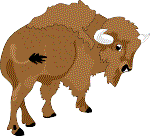PLAINS FIRST NATIONS and the BISON


Thousands of years before the guns and horses arrived in North America the First Nations of the Plains hunted the bison on foot. They used spears and later bows and arrows for the hunt. They had several ways to capture the bison. The "Buffalo Pound" and "Buffalo Jump" methods were used to kill large numbers of animals.
- The BUFFALO POUND method
The bison were lured into a coulee (ravine) by a hunter who dressed in buffalo robes. Then the other hunters, who were lined along the coulee, stampeded the animals into a log corral (closed-in place). They killed the bison with spears.
- The BUFFALO JUMP method
"Chasers" or "runners" would lead the animals towards a cliff where others waited behind rocks and trees. People waved blankets and shouted forcing the animals over the edge of the cliff. Others waited at the bottom of the cliff to kill the crippled animals.
- Sometimes men covered in buffalo robes or wolf skins followed the animals waiting for the best time to kill them.
- Hunting parties would surround a herd and creep up as close as possible. When given a signal each hunter would aim at a target animal. They had to be quick and accurate before the buffalo stampeded.
- Hunters drove the bison into deep snow and then killed them.
- The animals were attacked at water holes where they were unable to get away. Another method of driving herds of deer, pronghorn and bison into streams was by burning grass and forcing the animals to a river.
- The CHASE method
This method was used if the hunters had horses. A hunting party would charge the herd and get as close as they could to a bison, then shoot it with a bow and arrow or gun.
- In the summer several bands would get together to hunt the bison. More bison were killed this way. The meat was divided according to the needs of each family.
With the arrival of horses and guns to the prairies the way of life for the Plains Peoples changed. It was much easier to kill the bison. As more people came to the prairies larger numbers of bison were killed. By 1880 the huge herds of bison had disappeared.
Buffalo Pound Provincial Park in southern Saskatchewan was named after the surrounding area which was once used for buffalo hunts. There are areas within the park which were used by the hunters to corral the animals. The bison were stampeded into the pounds and then killed. In 1972 plains bison were reintroduced to the park.Head-Smashed-In Buffalo Jump (near Fort Macleod, Alberta) is a World Heritage site where buffalo were chased, forced over cliffs, killed and processed.


The bison was very important to the Plains First Nations. They used every part of the animal. (diagram-using the bison)
- meat - roasted on the campfire, boiled, for pemmican and jerky, sausages
- hides with the hair left on - winter clothing, gloves, blankets, robes, costumes for ceremonies or for hunting.
- hides - ropes, blankets, shields, clothing, moccasins, bags, tipi covers, bull boats, sweat lodge covers, containers, drums, winter counts
- sinew (muscles) - bowstrings, thread for sewing, webbing for snowshoes, attaching arrowheads
- bones - for making hoes, shovels, runners for sleds, pointy tools, knives, pipes, scrapers, arrowheads, game dice
- horns - spoons, cups, bowls, containers to carry tobacco, medicine or gunpowder, headdresses, arrow points, toys
- hair - rope, pillow stuffing, yarn, shields, medicine balls
- beard - decoration on clothes and weapons
- tail - fly swatter, whip, tipi decoration
- brain - used for preparing the hides (to soften the skin)
- hoofs - rattles, boiled to make glue
- tallow - (fat) paint base, hair grease, for making candles and soap, used for making pemmican
- dung (manure chips) - fuel for campfires and smoke signals
- teeth - for decorating, necklaces
- stomach - containers for water and for cooking
- intestines - storage containers, used for making sausage
- bladder - medicine bag, water container, pouches
- skull - ceremonies and prayer

